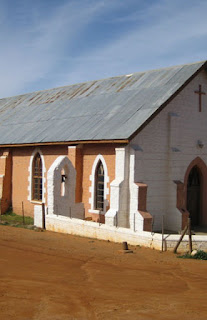The Namaqualand Mission is said to
have begun on 23 October 1816, the day when Jantjie Wildshutt and his elders
invited the Rev Barnabas Shaw and his wife, Jane, to accompany them to the home
of their Namaqua tribe, “Neiemies” or “Place of Gathering”, to become their
missionaries. Realising their need for a teacher who could tell them about the
“Great One in the Sky,” they met Shaw near Cape Town who accepted their
invitation. Neiemies later became Lilyfountain.
Shaw arrived in Cape Town earlier that year and was denied permission to preach by the Governor, Lord Charles Somerset. The London Missionary Society missionary Schmelen, told him of the need for missionaries in the interior, thus whilst looking for a place to set up a mission station, he met Wildshutt. Upon arrival at Lilyfountain, Shaw recorded: “We took up our abode in a hut belonging to one of the natives which had neither chimney, not even a door, and all in all, was of small dimension”.
The Namaqua people were hunters and lived a communal nomadic life. Shaw taught them agricultural skills and also started a school. In 1817, about 50 people where learning to read, and amongst Shaw’s early helpers where members of the Links family. In 1826 the first proper school was erected. Education has always been a priority at Lilyfountain, and in 1970 a Hostel was built. Today the school caters for learners from Grade 1 to Grade 8.
The Lilyfountain Mission was the first indigenous Methodist Society in South Africa. Shaw taught the people Methodist discipline and doctrines, and witnessed with the plough and spade as well as with his preaching, prayer and reading of scripture. One of Shaw’s achievements was to transform a nomadic farming community into an educated settled agricultural community with a permanent place of abode. Although they farmed cattle, sheep and goats, Shaw taught crop farming and horticulture.
Spiritually the Namaqualand Mission has come a long way. In 1817 Shaw had ten converts. By 1833 there were 120 full members and in 1835 they started to contribute financially to the Mission. By 1850 the membership had grown to 163 and today there’s almost 5 000 members.
Shaw’s contextual and caring ministry begun in 1816 which included a respect for Namaqua culture of never “eating, drinking or smoking alone” continues to this day.
Shaw arrived in Cape Town earlier that year and was denied permission to preach by the Governor, Lord Charles Somerset. The London Missionary Society missionary Schmelen, told him of the need for missionaries in the interior, thus whilst looking for a place to set up a mission station, he met Wildshutt. Upon arrival at Lilyfountain, Shaw recorded: “We took up our abode in a hut belonging to one of the natives which had neither chimney, not even a door, and all in all, was of small dimension”.
The Namaqua people were hunters and lived a communal nomadic life. Shaw taught them agricultural skills and also started a school. In 1817, about 50 people where learning to read, and amongst Shaw’s early helpers where members of the Links family. In 1826 the first proper school was erected. Education has always been a priority at Lilyfountain, and in 1970 a Hostel was built. Today the school caters for learners from Grade 1 to Grade 8.
The Lilyfountain Mission was the first indigenous Methodist Society in South Africa. Shaw taught the people Methodist discipline and doctrines, and witnessed with the plough and spade as well as with his preaching, prayer and reading of scripture. One of Shaw’s achievements was to transform a nomadic farming community into an educated settled agricultural community with a permanent place of abode. Although they farmed cattle, sheep and goats, Shaw taught crop farming and horticulture.
Spiritually the Namaqualand Mission has come a long way. In 1817 Shaw had ten converts. By 1833 there were 120 full members and in 1835 they started to contribute financially to the Mission. By 1850 the membership had grown to 163 and today there’s almost 5 000 members.
Shaw’s contextual and caring ministry begun in 1816 which included a respect for Namaqua culture of never “eating, drinking or smoking alone” continues to this day.


No comments:
Post a Comment